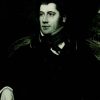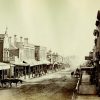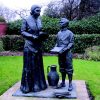Charles Hindley MP was a man with a highly developed social conscience and an international economic vision underpinned by local philanthropic sensitivity.
He was well-read, well-heeled and well-groomed in a Moravian Christian ethos. Why was he named in the streets of Adelaide? Firstly, he and John Rundle were paired in memoriam when the city’s streets were named. Both were industrialist MPs in the Reform Parliament, both were devout Christians and both were adored by their employees, of whom there were many.
Hindley was specifically named because he was a director of the South Australian Company. When the colonisation scheme looked like failing for want of capital, and George Fife Angas and his board of directors provided certainty by offering to buy all the remaining land orders in the name of the company and at the discount price of twelve shillings per acre, they took up £35,000 worth and Hindley, Rundle, Henry Kingscote, Abel Smith and Angas were among the contributors so to do.
Hindley was born at the Droylsden Moravian settlement of Fairfield on 25 June 1796.
The Moravian communities generally remained defiantly anti-Catholic throughout and exchanged personnel and resources. They incorporated their religious practices strongly into their daily lives. Socially and organisationally, precepts of inclusion, cooperation and fairness were paramount. Such values were indelibly etched into Hindley’s mind and he behaved accordingly throughout his short life.
He showed sufficient intellectual prowess at school and was invited to Gracehill in Ireland, where he could prepare for a clerical ministry back at Fairfield. At Gracehill, he tutored the younger boys in classics and mathematics, his incisive mind especially suited to the latter.
Hindley’s older brother unexpectedly passed away in February 1819 and the family cotton mills, in which he was a silent partner, were suddenly rudderless. Charles returned home from Gracehill to fill the breach. Between 1820 and 1840 large numbers of cotton mills sprang throughout the industrial north, and the pace of population growth and a concomitant deterioration in conditions provided great wealth for some and abject poverty for most. A turbulent economic legacy was inevitable.
With good management and careful decision-making Hindley succeeded in acquiring a succession of cotton mills. Amid the industrial turmoil of the mid-1820s, he quickly acquired great wealth. However, he never forsook his employees.
He advocated, financially supported and lobbied for a number of changes in the district. The revitalisation of the Mechanics’ Institute, which was originally established to provide technical education for working men, was first on Hindley’s agenda and became the subject of his first recorded speech to the population of Ashton. At this same meeting Hindley was ensconced as patron. He remained President of the governing body of the Mechanics’ Institute until his death in 1857. With the funds he injected into the institute, books, furnishings, library facilities, lecture rooms and bookkeeping staff were all made readily available to the young working-class men who frequented them on a needs basis. This is a heritage which older South Australians will recognise. It is no coincidence that such institutions could also be found in nineteenth-century Adelaide, as it demonstrates the rich vein of social and educational commitment possessed of so many of South Australia’s founders.
In 1822, not long after he assumed control of the family cotton mills, Hindley married Hannah Buckley (1801–1837), the daughter of Charles Buckley, another mill owner, from nearby Mossley. They had six children, but only two survived infancy. Unfortunately Mrs Hindley also died, on 15 July 1837, aged 36, just as Charles had entered parliament. He was devastated. Hindley’s new wife, a Miss Ann Fort from Read Hall who he married in 1839, ably assisted his daughters in the church school they established in the name of their mother. Ann Fort died on 16 December 1854.
Given the groundswell for electoral change in Britain, it is not surprising Hindley’s attention turned to politics. Both he and a Dr Campbell set about lobbying for a new parliamentary seat in the region (in 1831) and one for Ashton-under-Lyne was granted, the constituency being confined essentially to the town boundaries of Ashton.
In the aftermath of the Reform Bill of 1832, which enfranchised large numbers of previously unrepresented British citizens at the ballot box, Hindley put himself forward as a candidate for Ashton on an alternative liberal ticket but was narrowly defeated. Running on a reformist platform, his main plank was improved working conditions for factory workers, especially those in the textile industry.
At the subsequent election in 1835 Hindley swept into power as the member for Ashton-under-Lyne and continued to hold this seat until his death in 1857. In all, he spent 23 years in parliament, winning the seat on seven successive occasions, four of them unopposed. He was an extremely popular local member, described as an advanced liberal rather than a radical, and is still revered today in Droylsden, where a blue heritage plaque to his memory remains displayed prominently at Fairfield.
Hindley used mathematics to challenge the excesses of economic privilege in British society. Those wanting to buy property at the lower end of the market were paying stamp duties several hundred times more heavily than those with wealth. Artisans wanting to borrow smaller amounts of money to run small cottage industries or local businesses were unequally penalised in terms of the amount of interest paid. In this speech Hindley challenged the inequities being applied to stamp duties on annuities, insurances, probates and auctions.
He opposed the Corn Laws throughout his parliamentary career. He vented spleen against them in speeches in 1835 and 1841, especially where he was able to show how they impacted the terms of international trade. This was probably Hindley’s finest hour and ensured his place in history. In calling for the complete abolition of the Corn Laws in 1842 he supported the Corn Bill of 1846, which enshrined their progressive abandonment. Kofi Addo argues that Hindley is more rightly the greatest pioneer of international labour legislation.
In 1836 a group calling itself The London Working Men’s Association convened in London under the tutelage of a William Lovett. Their aim was to unite the working classes and ‘to place all classes of society in possession of the equal political and social rights’. It was the genesis of the Chartist movement and by 7 June 1837 the group had enlisted the support of several MPs including Hindley. At the British coffee houses in London they sat to hammer out what is now known as The People’s Charter,which was to deliver to all men in Britain important social and political changes.
Hindley took his commitment to peace so strongly he joined the Peace Society, which had formed in London as early as 1816, eventually becoming President in September 1843 until the organisation lapsed in 1854. During his presidency, he mounted the first ever International Peace Congress.
Hindley never came to South Australia. He did, however, benefit from being a director of the South Australian Company. Like Angas and many of the other directors, he also had interests in banking, especially The Union Bank of Australia, which was managed and operated by new colonists throughout Australia. The first branch opened in Launceston in May 1838 and with such a good start it grew to be a powerful player in the Australian banking industry.
As railway companies spread relentlessly across the landscape, Hindley successfully lobbied for a railway station in Ashton on the Manchester, Sheffield and Lincolnshire spur line. This immediately put large numbers of his constituents in touch with all the major centres of the north and with Greater London. He also lobbied for a separate postal district for Ashton.
Charles Hindley was never a very strong man and his heart troubled him as he got older. When his second wife died unexpectedly he was much more subdued in parliament, and when his only surviving daughter then died at the beginning of 1857 it is hard to resist the conclusion that he died towards the end of that same year of a broken heart. In his last year he didn’t speak in the House, preferring to sit quietly through those debates he did attend. He died at Dartmouth House in Westminster on 1 December 1857 and is buried at the Moravian cemetery in Chelsea with the rest of his family.








Comments